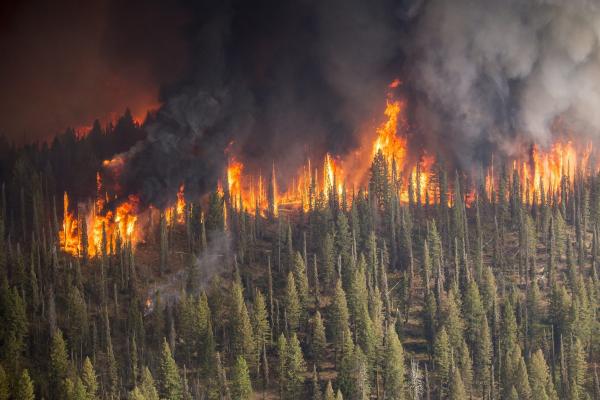The Resilience of Hot-Dip Galvanized Structures in Wildfires
With wildfires becoming increasingly prevalent natural disasters, the need for robust and fire-resistant structures is more critical than ever. For years, hot-dip galvanized (HDG) utility structures have shown exceptional performance in the face of intense heat and flames of wildfires. In 2022, the Association for Materials Protection and Performance (AMPP) released a comprehensive report detailing the impact of wildfires on corrosion resistance, material properties, and mechanical integrity of power transmission poles, including HDG structures and utility poles.1 The report concluded that HDG structures exhibit outstanding performance under wildfire conditions due to the protective nature of the galvanized coating. HDG coatings not only shield the underlying structural steel from heat, but also offers remarkable durability. Furthermore, the coating is conductive and non-combustible, providing additional protection against the initiation of wildfires.

It is important to note both heat and duration play critical roles in determining the impact of wildfires on HDG. Oftentimes, wildfires provide the necessary heat but lack the required duration to permanently damage the integrity of HDG structures and power poles. For instance, the AMPP report found even though wildfire temperatures can easily surpass 1,000 °F (538 °C), they usually do not last long enough to compromise the structural integrity of a hot-dip galvanized structure. For more detailed information, you can read the full report Adverse Impacts of Wildfires on Power Industry Steel Structures. Below is a brief summary of some of the many advantages HDG structures have in wildfires.
Advantages of HDG Structures in Wildfires:
First, HDG structures play a crucial role in preventing wildfires before they start. Their conductive and non-combustible properties significantly reduce the risk of fires caused by arcing and lightning, which are two of the most frequent wildfire ignition sources.
In addition to their non-combustible properties, HDG structures provide excellent heat protection against the effects of fire. Steel's mechanical properties are temperature-dependent and can be adversely affected by exposure to the intense heat of a wildfire. When steel temperatures exceed 1,112 °F (600 °C), nearly 50% of its strength can be lost. However, the zinc coating on HDG structures acts as a barrier, effectively preventing direct contact between the steel and flames. This barrier significantly slows down the transfer of heat to the steel, minimizing the risk of structural failure caused by excessive heat exposure. Even in scenarios where the galvanizing may be compromised, the zinc coating acts as a sacrificial layer, safeguarding the base steel from degradation of its mechanical properties. Furthermore, the zinc coating inhibits the formation of harmful oxides on the steel surface, thereby enhancing the fire resistance of HDG structures. A 2017 IFireSS study demonstrated these and other performance benefits of hot-dip galvanized steel structural members in fire conditions compared to steel members with bare or rusted surfaces.2

Another advantage of HDG structures is the exceptional durability and performance of the zinc coating, even at elevated temperatures. While pure zinc has a low melting point of 787 °F (419.5 °C) and the more robust inner iron-zinc intermetallic phases melt between 986 °F (530 °C) and 1,346 °F (730 °C), HDG structures are rarely exposed to wildfires for a duration long enough to reach these temperatures.3 Testing performed by the Australian Commonwealth Scientific and Industrial Research Organization (CSIRO) found under typical wildfire conditions, where temperatures can easily reach 1,000 °F (538 °C), steel structures' temperatures did not exceed 662 °F (350 °C).4 A separate study carried out by the Galvanizers Association of Australia (GAA), revealed despite achieving surface temperatures of 968 °F (520 °C) in their small-scale burn test, the hot-dip galvanized coating remained 100% intact.
Hot-dip galvanizing provides a reliable and durable solution for protecting structures in wildfire-prone areas. The metallurgically-bonded zinc coating acts as a powerful barrier against high temperatures and corrosion, ensuring the structural integrity and longevity of the steel components. As communities continue to confront the escalating threat of wildfires, hot-dip galvanized structures offer a viable and reassuring solution, safeguarding lives and property against these destructive forces of nature.
Footnotes:
- AMPP TR21505-2022, Adverse Impacts of Wildfires on Power Industry Steel Structures https://store.ampp.org/ampp-tr...
- Mensinger, Martin & Gaigl, Christian. (2017). “Hot dip galvanized steel constructions under fire exposure,” presented at IFireSS 2017 – 2nd International Fire Safety Symposium, Napes, Italy, June 2017.
- Fossa, “Performance and Inspection of HDG Exposed to Extreme Temperatures,” American Galvanizers Association (AGA) Knowledge Base, March 2, 2020, https://galvanizeit.org/knowle... (February 4, 2021).
- W.I.K. McLean, P.J. Golding, and A.M. Sheehan, “Performance of Protective Coatings on Small Steel Bridges Subject to Bushfires,” presented at 8th Australian Small Bridges Conference, Surfers Paradise Marriott, Queensland, Australia, November 2017.
© 2025 American Galvanizers Association. The material provided herein has been developed to provide accurate and authoritative information about after-fabrication hot-dip galvanized steel. This material provides general information only and is not intended as a substitute for competent professional examination and verification as to suitability and applicability. The information provided herein is not intended as a representation or warranty on the part of the AGA. Anyone making use of this information assumes all liability arising from such use.


